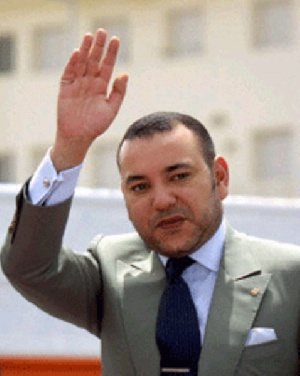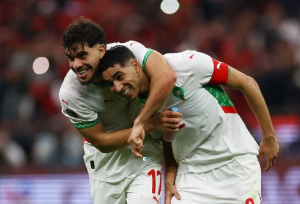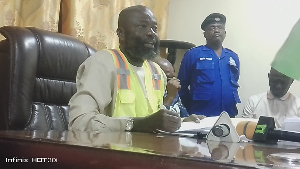When Moroccan referee Bouchaib El Ahrac was named, together with his two compatriots Yousef Mabrouk and Mohamed Al Ahmdi, to officiate the first leg of Ghana’s 2014 World Cup qualifier against Egypt on October 15th in Kumasi, not many Ghanaians were jubilant.
Many were, indeed, quite blunt in their disapproval citing, among other reasons, Morocco’s geographical proximity to Egypt and the possibility of that fact influencing the Moroccan referees to be biased towards their north African brothers.
“It could go against us. We must worry. We can be cheated. Anything can happen but until the final whistle is blown and I know Ghana has won I won’t totally trust the Moroccans to be honest in their decision making,” former Black Stars player Odartey Lamptey, speaking the mind of several Ghanaians, quipped.
Pleasantly surprising, however, the Moroccans exhibited admirable professionalism during the match which ensured Ghana’s 6-1 goal win over Egypt; and, thereby also highlighted Ghanaian’s ignorance of the essential Moroccan character and its high premium on fair-play.
That same ignorance, unfortunately, also seems to characterise much of the Ghanaian public commentary on Morocco and western Sahara.
Since its annexation of the Western Sahara in 1975, Morocco has used incentives and threats to win the support or at least the acquiescence of the indigenous population. Such quest for authority and legitimacy has been contested locally, even if the prospect of an independent Western Saharan state remains unrealistic. Most great powers, including the United States, wish that the disputed territory remain Moroccan. Western governments fear the possibility of another weak state, almost the size of Britain, appearing in an area already afflicted by many fragile or failing states. Only a handful of Latin American and African countries hold contrary views.
The stand-off between Morocco and the Algerian-backed Popular Front for the Liberation of Saguia al-Hamra and Rio de Oro (Polisario), a Sahrawi independence movement founded in 1973 and based in Algeria, has already had disastrous human, economic, and political consequences across North Africa.
From the onset of the war in 1975 until the 1991 ceasefire, the conflict also caused the displacement of thousands of people (current estimates vary between 100.000 and 150.000), resulted in the death of thousands of fighters, and led to the division of the territory. On the one side, a heavily- fortified Moroccan zone, protected by defensive walls (called the ‘Berm’) built in the mid-1980s and manned by 150,000 soldiers, constitutes 85 per cent of the territory. The Polisario controls the remaining area.
In light of the growing instabilities in and around North Africa and the difficulties of controlling trans-border terrorism and militancy, the international community is increasingly setting sights on the Western Sahara conflict as a potential stability risk for the region. United Nations Secretary-General Ban Ki-moon recently warned about the vulnerability of the Sahrawis in the Polisario-controlled refugee camps in southwest Algeria to recruitment by ‘criminal and terrorist networks’. Many youths, he added, are also expressing ‘support for radical courses of action such as resuming hostilities against Morocco’. To stave off such scenarios, Ban Ki- moon has urged both Morocco and the Polisario to engage ‘in genuine negotiations’ and embrace ‘a logic of give and take’ to break the cycle of unproductive actions and reactions. He has also called on all interested parties (the US, France, Spain, the United Kingdom and Russia) to ramp up pressure for the resolution of the conflict.
Morocco retrieved the Sahara in 1975 under the Madrid accords it signed with Spain and Mauritania following that year’s Green March by some 350, 000 volunteers from all the regions of the Kingdom converged at Tarfaya to liberate and reunite the southern provinces to the motherland Morocco.
The Green March followed the October 1975 advisory opinion of the International Court of Justice which had confirmed that the Sahara was not a ‘terra nullius’ or ‘no man’s land’ since there had been legal allegiance between the Kingdom of Morocco and the territory.
Thereafter, on November 6, 1975, the Moroccan flag was hoisted on the Sahara. Before then, the southern provinces were deprived of the most basic facilities of water, telecommunications, health, roads, ports and airports. But following Morocco’s recovery of the territories, the territory now enjoys a high level of development.
Beyond that, Morocco also plans to grant the southern provinces, or the Sahara, autonomy under Moroccan sovereignty.
The Moroccan proposal is in line with the relevant international standards, and respect of regional specificities and the expectations of the local populations, analysts say.
According to the autonomy plan, the Sahara populations will themselves run their affairs democratically, through legislative, executive and judicial bodies enjoying exclusive powers. They will have the financial resources needed for the region’s development in all fields, and will take an active part in Morocco’s national economic, social and cultural life.
The Moroccan state will only keep its powers in the royal domains, especially with respect to defense, external relations and the constitutional and religious prerogatives of His Majesty the King.
The plan, which aims to set the stage for dialogue and a negotiation process that would lead to a mutually acceptable political solution, draws inspiration from relevant proposals of the United Nations Organization, and from the constitutional provisions in force in countries that are geographically and culturally close to Morocco.
It is also based on internationally recognized norms and standards.
Specifically, the region’s semi-autonomous government shall exercise power over a wide range of issues, including, local administration, local police force and jurisdictions;: economic development, regional planning, promotion of investment, trade, industry, tourism and agriculture; region’s budget and taxation; infrastructure: water, hydraulic facilities, electricity, public works and transportation; housing, education, health, employment, sports, social welfare and social security; cultural affairs, including promotion of the Saharan Hassani cultural heritage; and, environment.
Additionally, the Sahara autonomous region shall have the financial resources required for its development in all areas.
Resources will come, in particular, from taxes, duties and regional levies enacted by the region’s competent authorities; proceeds from the exploitation of natural resources allocated to the region; the share of proceeds collected by the Moroccan State from the exploitation of natural resources located in the region; the necessary funds allocated in keeping with the principle of national solidarity; proceeds from the region’s assets.
The plan also provides that the parliament of the Sahara autonomous region shall be made up of members elected by the various Sahrawi tribes, and of members elected by direct universal suffrage, by the region’s population, including adequate representation of women in the parliament.
Ghana and Morocco have shared mutual interests and benefits in trade, tradable goods and cultural exchanges for centuries; and, since Ghana’s independence, Morocco continues to be an important partner of the country’s in both political and trade relations, with the north African country being a consistent destination for Ghana's fresh fruit exports, particularly pineapples and bananas.
Proud, like Ghana, of its deeply-rooted African identity, Morocco which also shares with sub-Sahara Africa’s first independent country the same vision of African Renaissance for a prosperous and united continent presently grants yearly scholarships to Ghanaian students to study in Morocco.
Opinions of Monday, 4 November 2013
Columnist: Martin-Luther C. King















